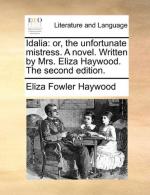|
This section contains 3,079 words (approx. 11 pages at 300 words per page) |

|
SOURCE: "The Later Haywood," in Masking and Unmasking the Mind: Disguising Romances in Feminine Fiction, 1713-1799, University of Delaware Press, 1990, pp. 101-8.
In the following essay, Schofield examines the theme of disguise in Haywood's Miss Betsy Thoughtless.
The History of Miss Betsy Thoughtless (1751)1 following the success of Collyer's Felicia to Charlotte (1744) and Richardson's Pamela (1741) demonstrates, first of all, Haywood's chameleon-like ability to follow the popular form, in this case, the morally acceptable romance-novel. Richardson's emphasis on the educability of the feminine public in their moral awareness is echoed in Haywood's treatment of her own Miss Betsy Thoughtless.
Unlike Richardson and Collyer, however, Haywood's Betsy Thoughtless initiates a new era in the presentation and depiction of the female character. With Pamela and all those earlier Gigantillas, Baronesses, and Placentias, the reader is unable to detect any movement on the heroine's part: each begins and ends in the same moral...
|
This section contains 3,079 words (approx. 11 pages at 300 words per page) |

|


